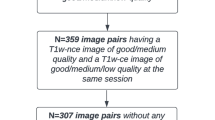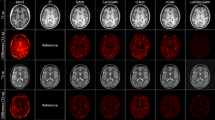Abstract
Over recent years, Deep Learning has proven to be an excellent technology to solve problems that would otherwise be too complex. Furthermore, it has seen great success in the area of medical imaging, especially when applied to the segmentation of brain tissues. As such, this work explores a possible new approach, using Deep Learning to perform spatial normalization on Magnetic Resonance Imaging brain studies. Spatial normalization of Magnetic Resonance images by tools like FSL, or SPM can be inefficient for researches as they require too many resources to achieve good results. These resources include, for example, wasted human and computer time when executing the commands to normalize and waiting for the process to finish. This can take up to several hours just for one study. Therefore, to enable a faster and easier method to normalize the data, a U-Net based Deep Neural Network was developed using Keras and TensorFlow. This approach should free the researchers’ time for other more relevant tasks and help reach conclusions faster in their studies when trying to find patterns between the analyzed brains. The results obtained have shown potential by predicting the correct brain shape in less than 10 s per exam instead of hours even though the model did not yet accomplish a fully usable spatial normalized brain.
Access this chapter
Tax calculation will be finalised at checkout
Purchases are for personal use only
Similar content being viewed by others
References
James, A.P., Dasarathy, B.V.: Medical image fusion: a survey of the state of the art. Inf. Fusion 19(1), 4–19 (2014)
Poldrack, R., Mumford, J., Nichols, T.: Spatial normalization. In: Handbook of Functional MRI Data Analysis, pp. 53–69. Cambridge University Press (2011)
FSL Wiki page. https://fsl.fmrib.ox.ac.uk/fsl/fslwiki. Accessed 18 Nov 2019
BET. https://fsl.fmrib.ox.ac.uk/fsl/fslwiki/BET. Accessed 18 Nov 2019
Smith, S.M.: Fast robust automated brain extraction. Hum. Brain Mapp. 17(3), 143–155 (2002)
FLIRT. https://fsl.fmrib.ox.ac.uk/fsl/fslwiki/FLIRT. Accessed 18 Nov 2019
FNIRT. https://fsl.fmrib.ox.ac.uk/fsl/fslwiki/FNIRT. Accessed 18 Nov 2019
Chollet, F.: Deep Learning with Python. Manning Publications Co. (2018)
Buduma, N.: Fundamentals of Deep Learning: Designing Next-Generation Machine Intelligence Algorithms, vol. 44, no. 5 (2017)
Goodfellow, I., Bengio, Y., Courville, A.: Deep Learning. MIT Press, Cambridge (2016)
Altaf, F., Islam, S.M.S., Akhtar, N., Janjua, N.K.: Going deep in medical image analysis: concepts, methods, challenges and future directions (2019)
Ren, S., He, K., Girshick, R., Sun, J.: Faster R-CNN: towards real-time object detection with region proposal networks. IEEE Trans. Pattern Anal. Mach. Intell. 39, 1137–1149 (2017)
Long, J., Shelhamer, E., Darrell, T.: Fully convolutional networks for semantic segmentation. IEEE Trans. Pattern Anal. Mach. Intell. 39, 640–651 (2017)
Simonyan, K., Zisserman, A.: Very deep convolutional networks for large-scale image recognition. In: ICLR, vol. 6 (2015)
Park, S., Lee, S.M., Lee, K.H., et al.: Deep learning-based detection system for multiclass lesions on chest radiographs: comparison with observer readings. In: European Radiology, pp. 1–10 (2019)
Nam, J., Park, S., Hwang, E., Lee, J., Jin, K., Lim, K., Vu, T., Sohn, J., Hwang, S., Goo, J., Park, C.: Development and validation of deep learning-based automatic detection algorithm for malignant pulmonary nodules on chest radiographs. Radiology 290(1), 218–228 (2019)
Brant-Zawadzki, M., Gillan, G., Nitz, W.: MP RAGE: a three-dimensional, T1-weighted, gradient-echo sequence–initial experience in the brain. Radiology 182(3), 769–775 (1992)
Liu, Q., Fu, M.: Dice loss function for image segmentation using dense dilation spatial pooling network (2018)
Acknowledgements
This work has been supported by FCT – Fundação para a Ciência e Tecnologia within the R&D Units Project Scope: UIDB/00319/2020. We gratefully acknowledge the support of the NVIDIA Corporation with their donation of a Quadro P6000 board used in this research.
Author information
Authors and Affiliations
Corresponding author
Editor information
Editors and Affiliations
Rights and permissions
Copyright information
© 2020 The Editor(s) (if applicable) and The Author(s), under exclusive license to Springer Nature Switzerland AG
About this paper
Cite this paper
Jesus, T., Magalhães, R., Alves, V. (2020). Spatial Normalization of MRI Brain Studies Using a U-Net Based Neural Network. In: Rocha, Á., Adeli, H., Reis, L., Costanzo, S., Orovic, I., Moreira, F. (eds) Trends and Innovations in Information Systems and Technologies. WorldCIST 2020. Advances in Intelligent Systems and Computing, vol 1161. Springer, Cham. https://doi.org/10.1007/978-3-030-45697-9_48
Download citation
DOI: https://doi.org/10.1007/978-3-030-45697-9_48
Published:
Publisher Name: Springer, Cham
Print ISBN: 978-3-030-45696-2
Online ISBN: 978-3-030-45697-9
eBook Packages: Intelligent Technologies and RoboticsIntelligent Technologies and Robotics (R0)




